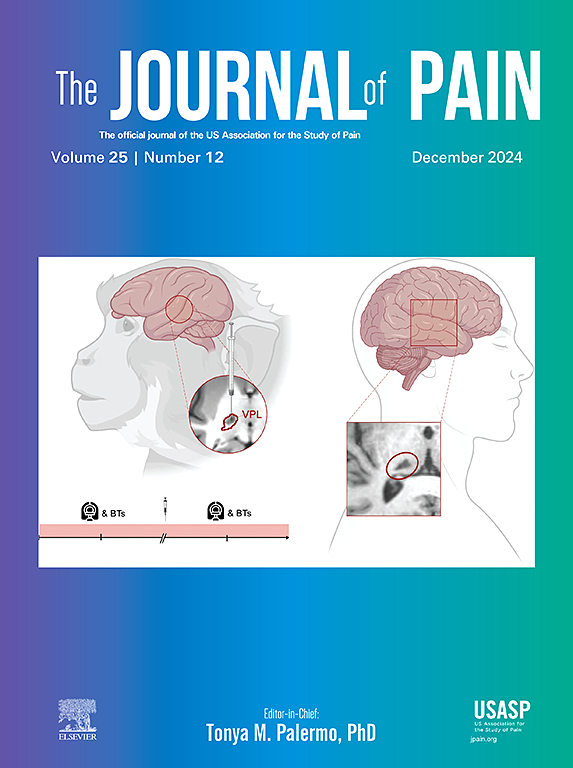Abnormal white matter microstructure in the amygdala-related fiber tract pathways in patients with trigeminal neuralgia: A multivariate analysis
IF 4
2区 医学
Q1 CLINICAL NEUROLOGY
引用次数: 0
Abstract
Trigeminal neuralgia (TN) is characterized by recurrent, severe facial pain often accompanied by negative emotional states such as anxiety and depression. However, the neurobiological mechanisms linking pain and emotion in TN remain unclear. In this cross-sectional study, we used diffusion tensor imaging (DTI) with seed-based fiber streamline analysis to examine amygdala-related white matter pathways in 46 TN patients and 35 age- and sex-matched healthy controls. Pain was quantified using the Penn Facial Pain Rating (PFPR) and the McGill Pain Questionnaire (MPQ), while emotional distress was assessed via the Pain Catastrophizing Scale (PCS) and the Pain Anxiety Symptom Scale (PASS). Compared with controls, TN patients exhibited significantly lower fractional anisotropy (FA) values (p < 0.05) and higher mean diffusivity in these fiber tracts, mainly located at the splenium of the corpus callosum, bilateral anterior corona radiata, and bilateral external capsule. Correlation analysis revealed that higher PCS scores were significantly associated with increased PFPR scores (r = 0.56, p < 0.001). Furthermore, mediation analysis demonstrated that abnormal FA in the amygdala-related fiber pathways partially mediated the relationship between negative emotions and facial pain intensity (direct effect: b = 0.475, p < 0.001; indirect effect: b = 0.084, p = 0.008). These results suggest that alterations in amygdala-related white matter microstructure may underlie the interplay between negative emotions and pain in TN, providing a potential neurobiological basis for future targeted interventions.
Perspective
This study suggests that pain catastrophizing may alter brain structure and contribute to chronic facial pain in trigeminal neuralgia patients. Early interventions targeting negative emotions could prevent further structural changes and improve clinical outcomes.
三叉神经痛患者杏仁核相关纤维束通路白质微结构异常:多变量分析
三叉神经痛(TN)的特征是反复发作,严重的面部疼痛,常伴有焦虑和抑郁等负面情绪状态。然而,在TN中连接疼痛和情绪的神经生物学机制尚不清楚。在这项横断面研究中,我们使用弥散张量成像(DTI)和基于种子的纤维流线分析来检查46名TN患者和35名年龄和性别匹配的健康对照者的杏仁核相关白质通路。采用Penn面部疼痛评分(PFPR)和McGill疼痛问卷(MPQ)对疼痛进行量化,采用疼痛灾难化量表(PCS)和疼痛焦虑症状量表(PASS)对情绪困扰进行评估。与对照组相比,TN患者表现出较低的分数各向异性(FA)值(p <;0.05),这些纤维束的平均弥漫性较高,主要位于胼胝体脾、双侧前放射冠和双侧外囊。相关分析显示,PCS评分越高,PFPR评分越高(r = 0.56, p <;0.001)。此外,中介分析表明,杏仁核相关纤维通路中FA异常部分介导了负性情绪与面部疼痛强度的关系(直接效应:b = 0.475, p <;0.001;间接效应:b = 0.084, p = 0.008)。这些结果表明,杏仁核相关白质微观结构的改变可能是负性情绪和TN疼痛之间相互作用的基础,为未来有针对性的干预提供了潜在的神经生物学基础。本研究提示疼痛灾难化可能改变大脑结构并导致三叉神经痛患者的慢性面部疼痛。针对负面情绪的早期干预可以防止进一步的结构变化并改善临床结果。
本文章由计算机程序翻译,如有差异,请以英文原文为准。
求助全文
约1分钟内获得全文
求助全文
来源期刊

Journal of Pain
医学-临床神经学
CiteScore
6.30
自引率
7.50%
发文量
441
审稿时长
42 days
期刊介绍:
The Journal of Pain publishes original articles related to all aspects of pain, including clinical and basic research, patient care, education, and health policy. Articles selected for publication in the Journal are most commonly reports of original clinical research or reports of original basic research. In addition, invited critical reviews, including meta analyses of drugs for pain management, invited commentaries on reviews, and exceptional case studies are published in the Journal. The mission of the Journal is to improve the care of patients in pain by providing a forum for clinical researchers, basic scientists, clinicians, and other health professionals to publish original research.
 求助内容:
求助内容: 应助结果提醒方式:
应助结果提醒方式:


